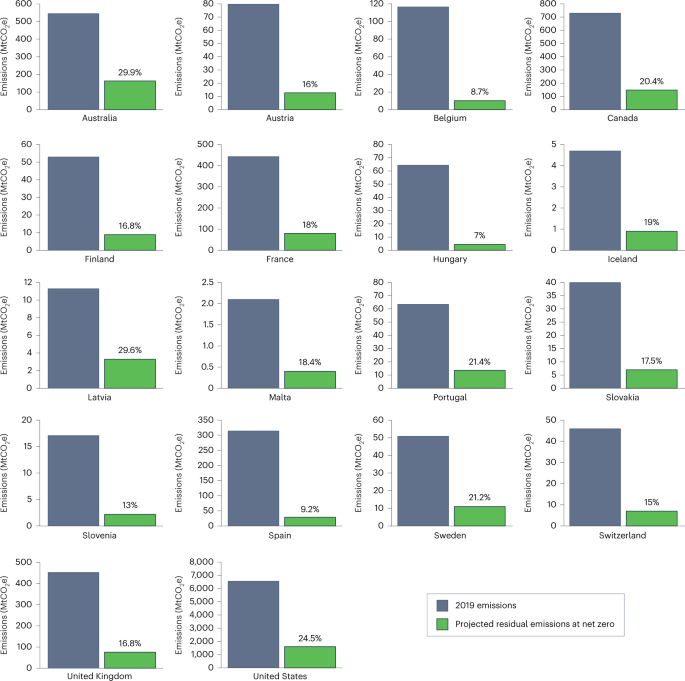Achieving net zero means balancing remaining emissions with carbon removal, and understanding the nature and scope of residual emissions is key to planning decarbonized energy and industrial systems. However, our analysis of long-term climate strategies shows that many governments lack clear projections for residual emissions at net zero.
Recommendations for policy
-
Current projections of residual emissions by 2050 by the countries that have quantified them indicate a need for high levels of removals, which risks compromising other sustainability goals.
-
Clear projections for the amount of residual emissions, sectoral and spatial distribution, and the types of greenhouse gas will help planning and investment for mid-century infrastructure.
-
Policymakers and researchers should develop standards for what can be reasonably deemed residual emissions, in order to avoid inflated expectations of emissions that cannot be compensated by removals.
-
Policymakers can support decarbonization planning by being explicit about whether residual emissions — and net zero as a goal — are a temporary stopgap towards decarbonization, or a state to maintain.
-
Both international and national policy action is needed to solve the problem of ensuring that removals are compensating for emissions from sectors and activities that are truly hard-to-abate.
based on H. J. Buck, W. Carton, J. F. Lund & N. Markusson Nature Climate Change https://doi.org/10.1038/s41558-022-01592-2 (2023).
The policy problem
Many governments have announced net-zero targets in the past few years, and now face the task of laying out specific roadmaps to reach those targets. Realistic net-zero roadmaps, as well as financing and planning the technologies and infrastructure for deep decarbonization and carbon removal, require governments to be able to project the amounts of residual emissions that will remain at net zero and understand what sectors will have remaining emissions. A mismatch between the amounts of residual emissions that countries expect and the available carbon removal capacity would jeopardize the goals laid out in the Paris Agreement. Thus, it is important to understand questions as to how residual emissions are defined, what amounts are projected, how they are distributed among sectors, and whether countries expect land-based or technological removals to compensate for these residual emissions.
The findings
Our results show that most countries with quantified projections are expecting large amounts of residual emissions by 2050, and that substantial carbon removal effort would therefore be needed. We found no consistent definition or use of the concept of residual emissions across the 50 long-term low-emissions development strategies (LT-LEDS) analysed. A majority of the LT-LEDS did not mention the concept of residual emissions at all, despite having a net-zero target. The Annex 1 country LT-LEDS that did quantify residual emissions at net zero projected substantial levels; on average, 18% of current emissions based on the lowest-level projections (Fig. 1). Agriculture and industry represented the largest sources of residual emissions in the 15 Annex I countries that included sectoral breakdowns. While some countries plan for land-based removals to compensate for their residuals, the biggest emitters expect land-based removals to fall far short of residuals, indicating a need for technological removal.
The 2019 emissions are from UNFCCC inventories, and show total greenhouse gas emissions without land use, land-use change and forestry (LULUCF). Percentages indicate residual emissions as a per cent of 2019 emissions. Figure reproduced with permission from Buck, H. J. et al. Nat. Clim. Change https://doi.org/10.1038/s41558-022-01592-2 (2023), Springer Nature Ltd.
The study
This study analysed 50 of the 51 LT-LEDS that had been submitted to the United Nations Framework Convention on Climate Change (UNFCCC) as of mid-2022. We looked at LT-LEDS because other sources of comparable data on country projections, such as national strategy documents or nationally determined contributions, tend to have shorter time horizons than would be relevant for net-zero goals. Importantly, most LT-LEDS present pathways, or what-if explorations of different scenarios for reaching desired targets. These scenarios and quantified projections inform the strategy, but are meant to be illustrative of possible futures rather than prescriptive. Right now, many of the countries that have submitted LT-LEDS are in the Global North. However, these countries are the first adopters of both LT-LEDS and net-zero targets, and their assessment and actions may set the tone for countries that follow.
Further reading
-
Fankhauser, S. et al. The meaning of net zero and how to get it right. Nat. Clim. Change 12, 15–21 (2022). This paper identifies the need for more clarity and transparency in the setting of net-zero targets.
-
Grassi, G. et al. Carbon fluxes from land 2000–2020: bringing clarity on countries’ reporting. Earth Syst. Sci. Data 14, 4643–4666 (2022). The latest published comprehensive dataset of land use, land-use change and forestry (LULUCF) fluxes on managed land.
-
Luderer, G. et al. Residual fossil CO2 emissions in 1.5–2 °C pathways. Nat. Clim. Change 8, 626–633 (2018). An analysis of key residual emissions determinants in modelled mitigation pathways.
-
Smith, H. B., Vaughan, N. E. & Forster, J. Long-term national climate strategies bet on forests and soils to reach net-zero. Commun. Earth Environ. 3, 305 (2022). A recent analysis of long-term strategies that examines projections for carbon removal.
-
Waisman, H. et al. A pathway design framework for national low greenhouse gas emission development strategies. Nat. Clim. Change 9, 261–268 (2019). A pathway design framework for national low greenhouse gas emission development strategies.
Acknowledgements
This work was supported by the Swedish Research Council Formas, grant no. 2018-01686 (H.J.B. and W.C.) and grant no. 2019-01953 (all authors).
Author information
Ethics declarations
Competing interests
The authors declare no competing interests.
Rights and permissions
About this article
Cite this article
Buck, H.J., Carton, W., Lund, J.F. et al. Countries’ long-term climate strategies fail to define residual emissions.
Nat. Clim. Chang. (2023). https://doi.org/10.1038/s41558-023-01614-7
-
Published: 09 March 2023
-
DOI: https://doi.org/10.1038/s41558-023-01614-7











